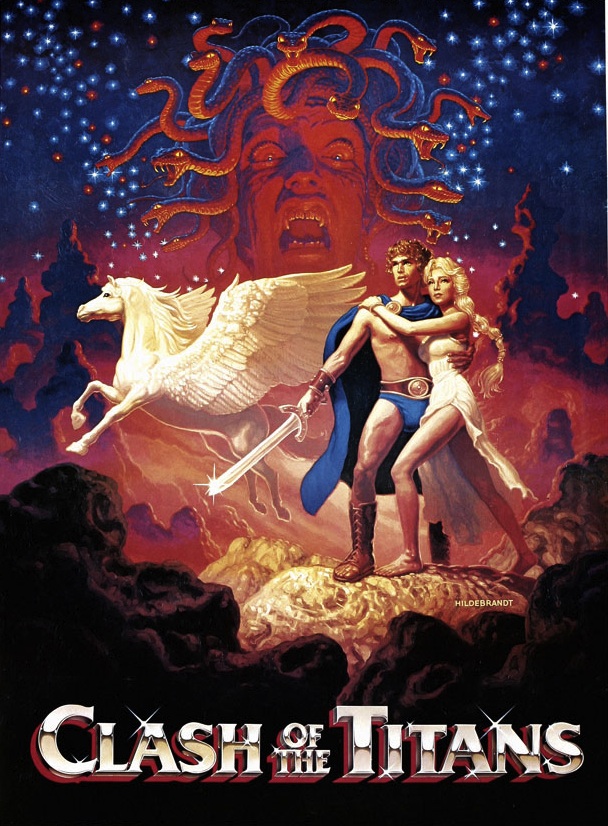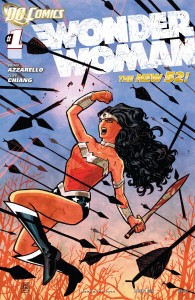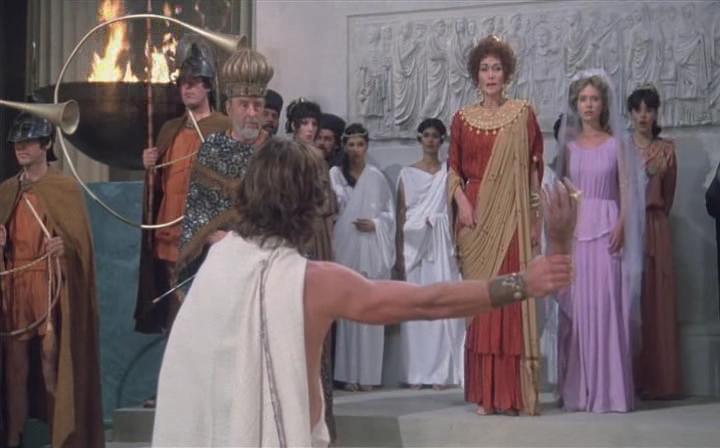
In a world… before pants…
From 1905’s Ulysses and the Giant Polyphemus (L’Île de Calypso: Ulysse et le géant Polyphème), and up to 2011’s Immortals and 2012’s Wrath of the Titans, Greek mythology has long proven an extremely rich and deep well from which fantasists and filmmakers have never hesitated to draw. The “swords and sandals” variety of genre film has waxed and waned in popularity just in my own lifetime — with stories that seemed extremely popular in the ’80s falling out of favor for years… until now. Yes, our pop culture seems filled with everything from very loosely-based “historical” epics that mix fact with fancy (300; Spartacus: Blood and Sand, et al),
to “pure” mythological epics which take the old stories and breathe modern sensibility into them (DC Comics’ Wonder Woman; the God of War video game series; the Percy Jackson series of young adult novels and films).
But there’s one story, one film in particular, a “sword and sandals” reinterpretation of the Perseus myth, which served as my personal entry not only into Greek mythology but into the fantasy genre in general. By modern standards the film suffers from overwrought, downright campy, performances by its leads, and the numerous stop motion special effects are laughably dated. But for me, personally, this is where it all began — my love for fantasy and (to a lesser extent in this case) the horror genre. It’s a British-American fantasy film released on June 12, 1981, with the suitably epic (though somewhat inaccurate) title, Clash of The Titans.
This, to me, was Greek mythology as it was originally intended: a cautionary tale of man versus the supernatural, where man was at a distinct disadvantage. The Olympians are not our friends, not patrons to be appealed to for succor, but rather petty tyrants with unimaginable power who are meant only to be appeased. Our hero, Perseus, only prevails because he has a god’s blood in his veins, and the mortal men he leads into battle in the end are only victims (and collateral ones at that) to the wanton cruelties of immortals. 2010’s big-budget remake starring Sam Worthington as Perseus and Liam “Release the Kraken” Neeson as Zeus (with a sequel, the aforementioned Wrath, released in 2012) benefits from 30 years of special effects technology, and certainly looks much better on a big screen (or a smaller one, for that matter). But for my money, I much prefer the Desmond Davis-helmed feature with its operatic leads and Ray Harryhausen-crafted stop motion monsters. In a time before Lucasfilm was A-list and James Cameron was sweeping Academy Awards, Harryhausen was the go-to guy for making the impossible seem real on screen.
And Clash of the Titans was his swan song.
Filmed at various locations which provide a sort of who’s who of fantasy/period piece filming sites from the ’70s onto today — including Andulucia, Spain (ye land of Spaghetti Westerns), Campania, Italy (of Jason and the Argonauts fame), Malta (which would later serve as backdrop for 2000’s Gladiator and 2004’s Troy, but which served here as the site for the climactic scene with the Kraken),
 and the considerably less-exotic (but much more storied) Pinewood Studios in Buckinghamshire, England, (where, even today, seemingly everything is filmed that isn’t shot in Hollywood) — Clash in many ways serves as a bridge between the genre films of the late ’60s, ’70s and early ’80s, up to the FX-driven renaissance which began with Star Wars only four years earlier. Although Harryhausen was at the top of his game for this production, this was (for better or worse) an actor-driven drama, and perhaps Harry Hamlin and company can be forgiven for taking themselves a bit too seriously in a film which serves as a sort of belated capstone for pre-Lucasfilm fantasy fare.
and the considerably less-exotic (but much more storied) Pinewood Studios in Buckinghamshire, England, (where, even today, seemingly everything is filmed that isn’t shot in Hollywood) — Clash in many ways serves as a bridge between the genre films of the late ’60s, ’70s and early ’80s, up to the FX-driven renaissance which began with Star Wars only four years earlier. Although Harryhausen was at the top of his game for this production, this was (for better or worse) an actor-driven drama, and perhaps Harry Hamlin and company can be forgiven for taking themselves a bit too seriously in a film which serves as a sort of belated capstone for pre-Lucasfilm fantasy fare.
But it isn’t just the lack of a Lucasfilm stamp or Cameron credit which sets Clash of the Titans apart from the ’80s renaissance. This film, despite its PG rating, was very much a “pulp” film, with character deaths aplenty and a plot which was less about “good” versus “evil” than it was about clashing egos and powerful men, women and gods answering insults with murder. Perseus himself comes off as something of a blowhard. His advantages are largely handed to him. And unlike the subdued, tortuous performance of Sam “If I do this, I do it as a man” Worthington in the 2010 remake, Hamlin’s clean-shaven, curly-locked Perseus seems just fine being the son of Zeus and leading his company to certain death against demon dogs, Gorgons, and giant scorpions as he quests for what he needs to save the life of Andromeda, his bride to be — a woman who’s hand he won in marriage earlier in the movie by literally producing the hand of another would-be suitor…
But the highlight of this film, for me, and what sets this one apart from its CGI-laden successor, is the Medusa scene. Here we have something that would fit right into any classic horror film…
Perhaps nostalgia gets in the way of my viewing here, but personally I think this Medusa is downright creepy. The stop motion and dim lighting actually adds to the overall effect to create a tension-filled cat and mouse scenario where you actually worry about our hero’s chances. Perseus and the Medusa are fighting (or rather hunting one another) in a dark confined space, and when the Medusa isn’t pelting Perseus’s men with arrows, she’s killing them straight out by simply staring at them!
Compare it to this scene, which definitely looks “cooler”, but loses a lot of the tension of the original…
For one, the Medusa in this version is kinda hot (snake hair and tail notwithstanding) — and with the lighting, music and wide open battlefield, this seems less like a monster hunt and more like a video game boss battle. I was never concerned for the lives of any of the characters involved, even as I watched them fall one by one, because I knew that the Medusa was only one slow motion swing away from getting her head lopped off by the hero… although it does look cool.
In 2012, Worthington, Neeson and company return to the story they remade in 2010, and finally realize that Clash sequel which never came to be in the early ’80s. Unlike the proposed Force of the Trojans, which would have detailed the story of Aeneas’s flight from Troy at the conclusion of the Trojan War (for those not up on their Greek mythology, Aeneas is that kid who Orlando Bloom gives the sword to at the end of Troy), Wrath of the Titans sees the return of Worthington’s Perseus, sporting Hamlin-esque longer locks, and actually “clashing” against “Titans” for the first time ever on screen — as the predecessors of the Greek gods awaken to take their vengeance against their usurper children, the Olympians, and tap into that 2012 zeitgeist of apocalyptic terror just in time for the early blockbuster holiday season.
I actually enjoyed the Clash remake just enough to look forward to Wrath, if only to see Liam Neeson have another turn at Zeus (sorry fans of the the original, but I prefer Neeson’s Zeus to Olivier’s… even if I can’t believe I just typed that). But, barring the intervention of a time machine, Davis’s original Clash of the Titans will forever remain my gateway into the realms of fantasy, horror and science fiction (hi, Bubo!). And even if I take a too-critical eye to it today as a 30-something adult, there will always remain that little six year-old who gazed in wonder at Harry Hamlin’s exploits on the small screen on a Saturday afternoon oh so many years ago. Where too many fantasy films since Star Wars seem less like actual films, and more like special effects portfolios, Clash of the Titans still holds up today as a classic of the genre, and an example of fantastical storytelling over FX storyboarding.

